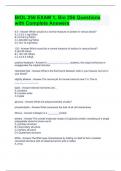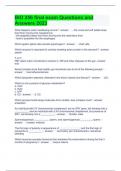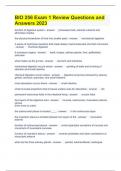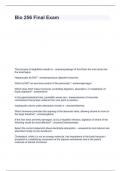Bio 256 final exam b - Study guides, Class notes & Summaries
Looking for the best study guides, study notes and summaries about Bio 256 final exam b? On this page you'll find 4 study documents about Bio 256 final exam b.
All 4 results
Sort by
Bio 256 Final Exam B

-
BIOL 256 EXAM 1, Bio 256 Questions with Complete Answers
- Exam (elaborations) • 15 pages • 2024
- Available in package deal
-
- $14.49
- + learn more
BIOL 256 EXAM 1, Bio 256 Questions with Complete Answers enzyme-substrate - Answer-When carbonic anhydrase and carbonic acid are temporarily joined together, they form ___________. A) an allosteric complex B) a reactant-product complex C) an isoenzyme D) an enzyme-substrate complex lactic acid - Answer-As a result of anaerobic respiration in humans, glucose is converted to A) pyruvic acid. B) lactic acid. C) citric acid. D) acetyl CoA. lipids - Answer-Which of the follow...

-
BIO 256 final exam Questions and Answers 2023
- Exam (elaborations) • 7 pages • 2023
-
Available in package deal
-
- $18.49
- + learn more
BIO 256 final exam Questions and Answers 2023 What happens when swallowing occurs? - the uvula and soft palate keep food from moving into nasopharynx - the epiglottis keeps food from moving into the respiratory tract - food is propelled into the esophagus Which gastric gland cells secrete pepsinogen? chief cells Which enzyme is important for actively breaking down protein in the stomach? pepsin T or F: FMT alters colon microbiota to resolve C. Diff and other diseases ...

-
BIO 256 Exam 1 Review Questions and Answers 2023
- Exam (elaborations) • 5 pages • 2023
-
Available in package deal
-
- $18.49
- + learn more
BIO 256 Exam 1 Review Questions and Answers 2023 function of digestive system processes food, extracts nutrients and eliminates residue the physical breakdown of food into smaller parts mechanical digestion A series of hydrolysis reactions that break dietary macromolecules into their monomers chemical digestion 6 accessory organs teeth, tongue, salivary glands, liver, gallbladder, pancreas what makes up the gi tract stomach and intestines mechanical diges...

Do you wonder why so many students wear nice clothes, have money to spare and enjoy tons of free time? Well, they sell on Stuvia! Imagine your study notes being downloaded a dozen times for $15 each. Every. Single. Day. Discover all about earning on Stuvia



